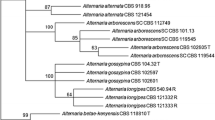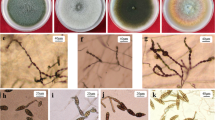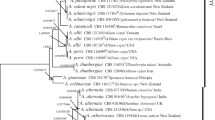Abstract
In this work, we assess the taxonomy of Alternaria species associated with leaf spot and blight disease on araliaceous plants in Korea. Alternaria araliae and A. panacis are recognized and a novel species, A. dendropanacis, is proposed based on sequence analysis and morphology. They can be differentiated by the combined analysis of Alt a 1, BT1, BT2, EF-1α, gpd and RPB2 gene sequences. Morphologically, the species are distinct by pigment production and conidial characteristics produced under standardized cultural conditions.




Similar content being viewed by others
References
Berbee ML, Pirseyedi M, Hubbard S (1999) Cochliobolus phylogenetics and the origin of known, highly virulent pathogens, inferred from ITS and glyceraldehydes-3-phosphate dehydrogenase gene sequences. Mycologia 91:964–977
Carbone I, Kohn LM (1999) A method for designing primer sets for speciation studies in filamentous ascomycetes. Mycologia 91:553–556
Chun J (1995) Computer-assisted classification and identification of Actinomycetes. Dissertation, Unversity of Newcastle
CSL (2006) Pest risk analysis for Alternaria panax. Summary pest risk analysis for PHSI interceptions. Sand Hutton, UK. Online publication
Dearness J, House HD (1940) New or noteworthy species of fungi. V Circ N Y State Mus 24:25–60
Deng JX, Kim CS, Oh ES, Yu SH (2010) First report of foliar blight caused by Alternaria panax on Dendropanax morbifera. Mycobiology 38:316–320
Deng JX, Paul NC, Park MS, Yu SH (2013) Molecular characterization, morphology, and pathogenicity of Alternaria panax from araliaceous plants in Korea. Mycol Prog 12:383–396
Forsberg LI (1983) New Disease: Alternaria panax on Umbrella tree. Australas Plant Pathol 12:7
Garibaldi A, Gilardi G, Gullino ML (2004) First report of Alternaria leaf blight of Aralia japonica caused by Alternaria panax in Europe. Plant Dis 88:82
Glass NL, Donaldson GC (1995) Development of primer sets designed for use with the PCR to amplify conserved genes from filamentous ascomycetes. Appl Environ Microbiol 61:1323–1330
Greene HC (1953) Notes on Wisconsin parasitic fungi. XVIII. Wisconsin Acad Sci Art Lett 42:69–81
Hall TA (1999) BioEdit: a user-friendly biological sequence alignment editor and analysis program for Windows 95/98/NT. Nucleic Acids Symp Ser 41:95–98
Hong SG, Cramer RA, Lawrence CB, Pryor BM (2005) Alt a 1 allergen homologs from Alternaria and related taxa: analysis of phylogenetic content and secondary structure. Fungal Genet Biol 42:119–129
Larkin MA, Blackshields G, Brown NP, Chenna R, McGettigan PA, McWilliam H, Valentin F, Wallace IM, Wilm A, Lopez R (2007) ClustalWand Clustal X version 2.0. Bioinformatics 23(21):2947–2948
Lawrence DP, Gannibal PB, Peever TL, Pryor BM (2013) The sections of Alternaria: formalizing species-groups concepts. Mycologia 105:530–546
Lawrence DP, Gannibal PB, Dugan FM, Pryor BM (2014) Characterization of Alternaria isolates from the infectoria species-group and a new taxon from Arrhenatherum, Pseudoalternaria arrhenatheria sp. nov. Mycol Prog 14:257–276
Levy E, Elkind G, Ben-Ze’ev IS (2006) First report in Israel of Aralia leaf spot caused by Alternaria panax. Phytoparasitica 34:269–271
Liu YJ, Whelen S, Hall BD (1999) Phylogenetic relationships among ascomycetes: evidence from an RNA Polymerse II Subunit. Mol Biol Evol 16:1799–1808
Miller JW (1969) An Alternaria leaf spot of Schefflera actinophylla. Plant Path, Circular no. 80, pp 2
Proctor JTA, Baily WG (1987) Ginseng: Industry, botany and culture. Hortic Rev 9:187–236
Pryor BM, Bigelow DM (2003) Molecular characterization of Embellisia and Nimbya species and their relationship to Altenraria, Ulocladium and Stemphylium. Mycologia 95:1141–1154
Pryor BM, Michailides TJ (2002) Morphological, pathogenic, and molecular characterization of Alternaria isolates associated with Alternaria late blight of pistachio. Phytopathology 92:407–416
Roberts RG, Reymond ST, Andersen B (2000) RAPD fragment pattern analysis and morphological segregation of small-spored Alternaria species and species groups. Mycol Res 104:151–160
Rotem J (1994) The genus Alternaria: Biology, epidemiology, and pathogenicity. APS Press St Paul, Minn
Simmons EG (1982) Alternaria: Themes and Variations (7–10). Mycotaxon 14:17–43
Simmons EG (2007) ALTERNARIA: an identification manual. CBS Fungal Biodiversity Centre Utrecht, the Netherlands, pp 38–41
Stamatakis A (2006) RAxML-VI-HPC: maximum likelihood-based phylogenetic analyses with thousands of taxa and mixed models. Bioinformatics 22:2688–2690
Tamura K, Peterson D, Peterson N, Stecher G, Nei M, Kumar S (2011) MEGA5: Molecular evolutionary genetics analysis using maximum likelihood, evolutionary distance, and maximum parsimony methods. Mol Biol Evol 28:2731–2739
Uchida JY, Aragaki M, Yoshimura MA (1984) Alternaria leaf spots of Brassaia actinophylla, Dizygotheca elegantissima, and Tupidanthus calyptratus. Plant Dis 68:447–449
Wen J, Plunkett GM, Mitchell AD, Wagstaff SJ (2001) The evolution of Araliaceae: a phylogenetic analysis based on ITS sequences of nuclear ribosomal DNA. Syst Bot 26:144–167
Whetzel HH, Rosenbaum J (1912) The diseases of ginseng and their control. U S Dept Agric Bur Plant Ind 250:44
Woudenberg JH, Groenewald JZ, Binder M, Crous PW (2013) Alternaria redefined. Stud Mycol 75:171–212
Woudenberg JH, Truter M, Groenewald JZ, Crous PW (2014) Large-spored Alternaria pathogens in section Porri disentangled. Stud Mycol 79:1–47
Yu SH (2001) Korean Species of Alternaria and Stemphylium. National Institute of Agricultural Science and Technology, Suwon, pp 100–106
Zhang TY (2003) Flora Fungorum Sinicorum, Alternaria, Vol. 16, 1st edn. Beijing, China, pp 55–61
Acknowledgments
The authors extend sincere thanks to Dr. Walter Gams for the nomenclature of the new species. This project was supported by a grant from the Regional Subgenebank Support Program of the Rural Development Administration (RDA) and the National Institute of Biological Resources, Republic of Korea.
Author information
Authors and Affiliations
Corresponding author
Rights and permissions
About this article
Cite this article
Deng, J.X., Li, M.J., Paul, N.C. et al. Alternaria species associated with araliaceous plants in Korea. Mycol Progress 14, 31 (2015). https://doi.org/10.1007/s11557-015-1052-0
Received:
Revised:
Accepted:
Published:
DOI: https://doi.org/10.1007/s11557-015-1052-0




